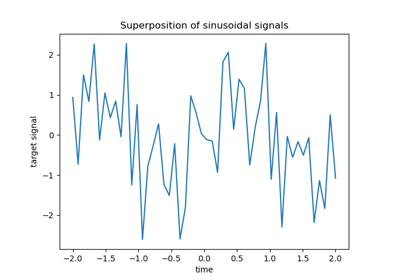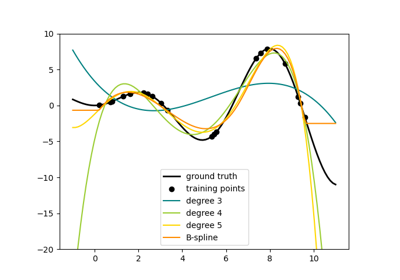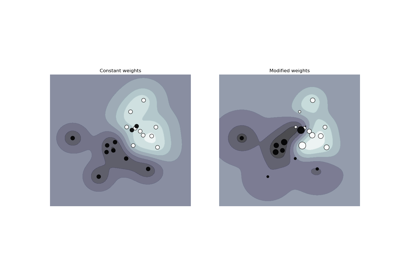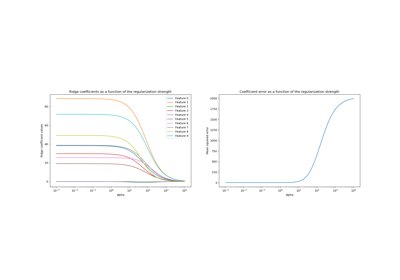注意
转到末尾以下载完整示例代码或通过 JupyterLite 或 Binder 在浏览器中运行此示例。
比较线性贝叶斯回归器#
此示例比较了两种不同的贝叶斯回归器
一种 贝叶斯岭回归
在第一部分中,我们使用普通最小二乘(OLS)模型作为基准,将模型的系数与真实系数进行比较。之后,我们展示了这些模型的估计是通过迭代最大化观测值的边际对数似然来完成的。
在最后一部分中,我们使用多项式特征展开来绘制 ARD 和贝叶斯岭回归的预测和不确定性,以拟合 X 和 y 之间的非线性关系。
# Authors: The scikit-learn developers
# SPDX-License-Identifier: BSD-3-Clause
模型恢复真实权重值的鲁棒性#
生成合成数据集#
我们生成了一个数据集,其中 X 和 y 呈线性关系:X 的 10 个特征将用于生成 y。其他特征对于预测 y 毫无用处。此外,我们生成了一个 n_samples == n_features 的数据集。这种设置对 OLS 模型来说具有挑战性,并可能导致任意大的权重。对权重进行先验假设和惩罚可以缓解这个问题。最后,添加了高斯噪声。
from sklearn.datasets import make_regression
X, y, true_weights = make_regression(
n_samples=100,
n_features=100,
n_informative=10,
noise=8,
coef=True,
random_state=42,
)
拟合回归器#
现在我们拟合两个贝叶斯模型和 OLS,以便稍后比较模型的系数。
import pandas as pd
from sklearn.linear_model import ARDRegression, BayesianRidge, LinearRegression
olr = LinearRegression().fit(X, y)
brr = BayesianRidge(compute_score=True, max_iter=30).fit(X, y)
ard = ARDRegression(compute_score=True, max_iter=30).fit(X, y)
df = pd.DataFrame(
{
"Weights of true generative process": true_weights,
"ARDRegression": ard.coef_,
"BayesianRidge": brr.coef_,
"LinearRegression": olr.coef_,
}
)
绘制真实和估计的系数#
现在我们将每个模型的系数与真实生成模型的权重进行比较。
import matplotlib.pyplot as plt
import seaborn as sns
from matplotlib.colors import SymLogNorm
plt.figure(figsize=(10, 6))
ax = sns.heatmap(
df.T,
norm=SymLogNorm(linthresh=10e-4, vmin=-80, vmax=80),
cbar_kws={"label": "coefficients' values"},
cmap="seismic_r",
)
plt.ylabel("linear model")
plt.xlabel("coefficients")
plt.tight_layout(rect=(0, 0, 1, 0.95))
_ = plt.title("Models' coefficients")
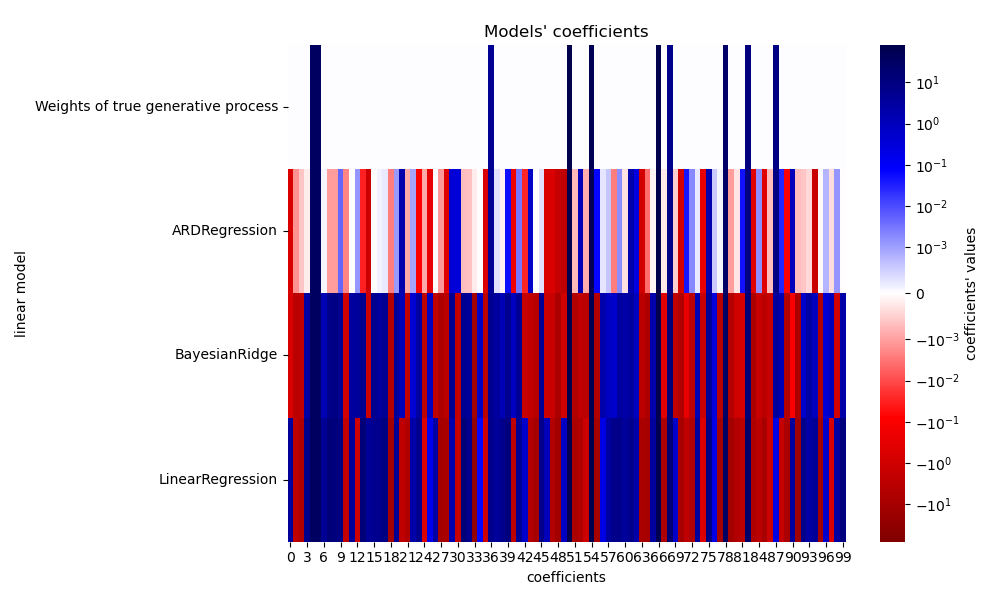
由于添加了噪声,没有一个模型能完全恢复真实权重。事实上,所有模型都有超过 10 个非零系数。与 OLS 估计器相比,使用贝叶斯岭回归的系数稍微向零移动,这使其更稳定。ARD 回归提供了一个更稀疏的解:一些非信息性系数被精确设置为零,而将其他系数移近零。一些非信息性系数仍然存在并保留较大的值。
绘制边际对数似然#
import numpy as np
ard_scores = -np.array(ard.scores_)
brr_scores = -np.array(brr.scores_)
plt.plot(ard_scores, color="navy", label="ARD")
plt.plot(brr_scores, color="red", label="BayesianRidge")
plt.ylabel("Log-likelihood")
plt.xlabel("Iterations")
plt.xlim(1, 30)
plt.legend()
_ = plt.title("Models log-likelihood")
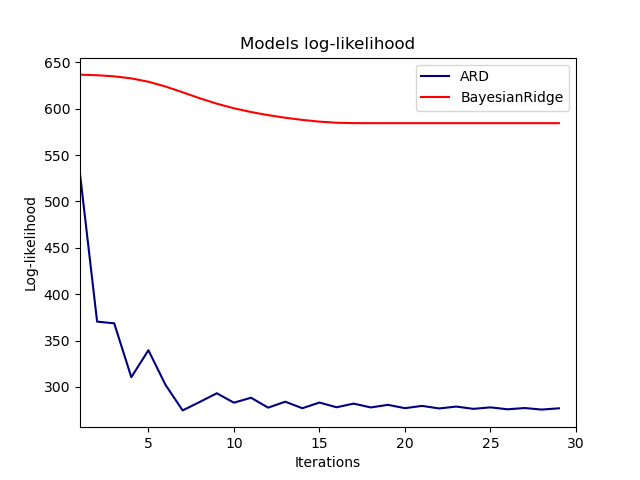
事实上,两个模型都将对数似然最小化到由 max_iter 参数定义的任意截止值。
具有多项式特征展开的贝叶斯回归#
生成合成数据集#
我们创建一个目标,它是输入特征的非线性函数。添加了遵循标准均匀分布的噪声。
from sklearn.pipeline import make_pipeline
from sklearn.preprocessing import PolynomialFeatures, StandardScaler
rng = np.random.RandomState(0)
n_samples = 110
# sort the data to make plotting easier later
X = np.sort(-10 * rng.rand(n_samples) + 10)
noise = rng.normal(0, 1, n_samples) * 1.35
y = np.sqrt(X) * np.sin(X) + noise
full_data = pd.DataFrame({"input_feature": X, "target": y})
X = X.reshape((-1, 1))
# extrapolation
X_plot = np.linspace(10, 10.4, 10)
y_plot = np.sqrt(X_plot) * np.sin(X_plot)
X_plot = np.concatenate((X, X_plot.reshape((-1, 1))))
y_plot = np.concatenate((y - noise, y_plot))
拟合回归器#
在这里我们尝试使用 10 次多项式来可能导致过拟合,尽管贝叶斯线性模型会对多项式系数的大小进行正则化。由于 ARDRegression 和 BayesianRidge 默认设置 fit_intercept=True,因此 PolynomialFeatures 不应引入额外的偏差特征。通过设置 return_std=True,贝叶斯回归器返回模型参数后验分布的标准差。
ard_poly = make_pipeline(
PolynomialFeatures(degree=10, include_bias=False),
StandardScaler(),
ARDRegression(),
).fit(X, y)
brr_poly = make_pipeline(
PolynomialFeatures(degree=10, include_bias=False),
StandardScaler(),
BayesianRidge(),
).fit(X, y)
y_ard, y_ard_std = ard_poly.predict(X_plot, return_std=True)
y_brr, y_brr_std = brr_poly.predict(X_plot, return_std=True)
绘制带分数标准误差的多项式回归#
ax = sns.scatterplot(
data=full_data, x="input_feature", y="target", color="black", alpha=0.75
)
ax.plot(X_plot, y_plot, color="black", label="Ground Truth")
ax.plot(X_plot, y_brr, color="red", label="BayesianRidge with polynomial features")
ax.plot(X_plot, y_ard, color="navy", label="ARD with polynomial features")
ax.fill_between(
X_plot.ravel(),
y_ard - y_ard_std,
y_ard + y_ard_std,
color="navy",
alpha=0.3,
)
ax.fill_between(
X_plot.ravel(),
y_brr - y_brr_std,
y_brr + y_brr_std,
color="red",
alpha=0.3,
)
ax.legend()
_ = ax.set_title("Polynomial fit of a non-linear feature")
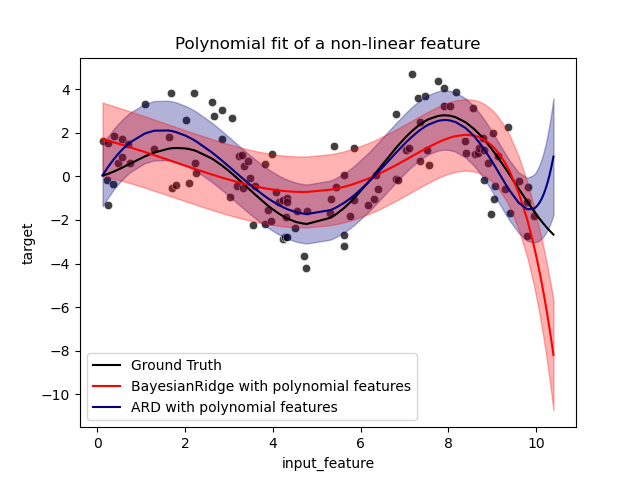
误差棒代表查询点预测高斯分布的一个标准差。请注意,当在两个模型中使用默认参数时,ARD 回归最好地捕获了真实值,但进一步减小贝叶斯岭的 lambda_init 超参数可以减小其偏差(参见示例 使用贝叶斯岭回归进行曲线拟合)。最后,由于多项式回归的固有局限性,两个模型在外推时都会失败。
脚本总运行时间: (0 minutes 0.530 seconds)
相关示例
